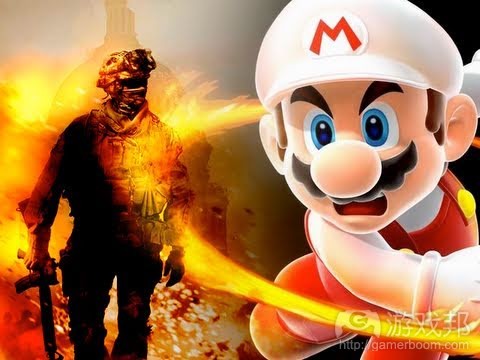休闲和硬核并非划分标准 用户粘性才是关键
从前,人们并不会将大量的钱投入休闲游戏中,反而是将更多的钱用于玩硬核游戏。但是随着时间的发展,情况却发生了变化。
当我在玩《FarmVille》这款休闲社交游戏时,我甚至为了迎合庄稼的收割时间而改变了自己的睡觉时间。我还创造了电子数据表以掌握庄稼的收成。同时我还经常潜伏于维基百科或各种论坛中研究农场布局以及提高种树/养殖比率的方法。如果你说这些并不是硬核行为,那我也无话可说了。
从现代视角来看,街机游戏也能够被当成休闲游戏。但是很明显的,像《游戏之王》这类游戏自然就仍属于硬核作品了。
相反地,当我在玩《魔兽世界》时,我一边在游戏中蹒跚前行,一边还需要观察着周边的事物,有时候还需要与敌人抗争并杀死它们。这里不存在任何能量升级,突袭等内容。我甚至未将自己的情感带进游戏中。可以说我并未全身心投入游戏中。如此看来,这对于我来说就是休闲游戏吗?
有人将现代的休闲游戏和硬核游戏比作“女孩游戏”和“男孩游戏”。这种说法更加强调设计的心理元素和市场营销线索而不是特定的设计元素。所以我认为这种说法也不是没有道理的。
但是作为一名优秀的游戏设计师,并且希望能够制作出真正优秀的游戏(获得更多的用户),我们则需要从不同角度进行思考,不再将休闲和硬核当成是游戏类型或者玩家原型,而是将其当成用户粘性类型进行分析。
有些游戏机制只是或多或少地带有一些深度的奖励和硬核关卡的用户粘性机制。例如一字棋游戏便很难吸引硬核玩家的注意。而与此同时,那些要求玩家投入更多时间和金钱却只能提供一些基本享乐的游戏(游戏邦注:特别是来自于大型工作室的MMO和AAA级游戏)则强迫玩家在休闲时间去体验更复杂的游戏。
我真心希望游戏能够让我自己选择沉浸于游戏中的程度。这样的设计才能促成更有价值的游戏体验;才能更好地回报玩家的投入。但是我却很反感那些强迫着我们经历硬核游戏体验,而不管我们是否愿意在休闲时刻面对这些内容的游戏。
这便是我为何如此抗拒《魔兽世界》这类游戏的原因——游戏中提供了大量你在休闲游戏体验中从未接触过的背景故事。你必须融入硬核研究行为中才能感受到这些故事的存在。或者像《光晕》那样,就算只是处理一些基本的游戏界面问题,也会呈现极端复杂的学习曲线。
这也是我为何希望游戏能够让玩家在遇到不擅长,或者认为没有尝试必要的内容时选择跳过按钮的原因。我之所以如此讨厌《超级马里奥银河》便是因为我不能按照游戏的要求跳过那个不断移动且充满洞穴的平台,所以尽管多年过去了我还是深陷于这个关卡中!而这究竟意味着我最终错过了《超级马里奥银河》这款游戏?还是说这款游戏失去了我这名玩家?
我们跨媒体设计师讨论了许多关于用户粘性深度的问题,而我们也希望通过绘制出一个三角形图像以代表不同类型玩家的组成(包括潜行者,业余玩家以及旁观者)。
如今的游戏设计师已经开始淡忘了休闲游戏与硬核游戏之间的区别,相反他们现在更加侧重于思考用户粘性的深度问题,即尝试着让游戏同时呈现休闲和硬核用户粘性。
游戏邦注:原文发表于2010年8月6日,所涉事件和数据均以当时为准。(本文为游戏邦/gamerboom.com编译,拒绝任何不保留版权的转载,如需转载请联系:游戏邦)
Casual vs. Hardcore for Game Designers
August 6, 2010
Once upon a time, a casual game was something you didn’t spend a lot of time or money on. A hardcore game was one you did. Obviously! And then we all grew up and things got complicated.
When I was playing Farmville, a casual social game, I engaged in sleep-shifting to maximize harvest times. I kept spreadsheets to work out the best min/max on crop mastery. I lurked in wikis and forums searching for better strategies for farm layout and tree/animal ratios. If those aren’t hardcore behaviors, I don’t know what is.
Arcade games would be considered casual through our modern lens, too. But King of Kong surely demonstrates that the play behaviors could get pretty solidly hardcore.
Conversely, when I played World of Warcraft, I toddled around for a little while looking at things and sometimes also killed stuff. There was no power-leveling, no raiding, precious little questing. I didn’t have a lot invested in the game emotionally. I dabbled. Was it not, then, a casual game for me?
There’s a suggestion that our modern usage of casual and hardcore are really code for “a girly game” and “a manly game.” More a gestalt of design and marketing cues than specific design elements. I think there’s a lot of truth to that.
But as game designers trying to make great games — and get as much audience share as we possibly can — we really need to look at this from a different angle entirely. Forget thinking about casual and hardcore as types of games. They aren’t. They also aren’t player archetypes. Casual and hardcore are types of engagement.
Sure, some game mechanics are more and less rewarding of deep, hardcore-level engagement. It’s not easy to be a hardcore player of, oh, Tic-Tac-Toe, for example. At the same time, some games — particularly MMOs and AAA titles from big studios — require a significant investment in time and money to get to a sort of baseline level of enjoyment, rendering it more difficult — though not impossible — to enjoy those games on a casual basis.
I strongly prefer games that give me choice in how much I want to engage. It’s just good design to make a game experience immediately rewarding, right? And it’s likewise good design to make a game more rewarding the more a player puts into it. But I reject game designs that funnel you toward a hardcore experience to such an extent that you cannot continue to play it on casual terms if that’s what you prefer.
This is why I’m annoyed by games like, oh, World of Warcraft, which have a sweep of backstory you’re never exposed to in a casual experience of the game. You have to engage in hardcore research behaviors to even discover they exist. Or games like Halo with a steep learning curve simply for handling the basic interface of the game.
This is also why I wish there were a button that let me skip parts of a game I’m bad at and find unrewarding to keep trying. I’m stuck on Super Mario Galaxy because I am not capable of leaping from one moving, hole-filled platform to another at the speed the game requires. I’ve been stuck on that level for a couple of years now, and it’s been about that long since I even fired up the game. Does this mean I’ve fundamentally lost Super Mario Galaxy? Or does it mean the game has lost me?
We transmedia designers talk a lot about depth of engagement, and we like to draw pretty triangular graphs that demonstrate how the bulk of your audience will always be lurkers, dabblers, spectators. Casual players. What does this say about games that consider themselves hardcore? I don’t know about you, but tells me they’re leaving money on the table.
Game designers, forget about casual games and hardcore players. There’s a false opposition there. Instead, think about depth of engagement. Try to make your game accessible to casual and hardcore engagement styles at the same time. The discussion has long been framed in unproductive language that won’t ultimately help anyone to make better games for more people. And at the end of the day, we can all agree better games are what we want, right?(source:deusexmachinatio)








































 闽公网安备35020302001549号
闽公网安备35020302001549号